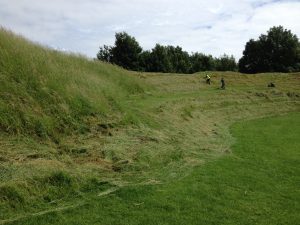
Raking after the mow. Maumbury Rings © Miles King
At this time of year (and with this amazing summer weather) hardly a day goes by when I don’t think how lucky I am to live in Dorset. Just a hundred yards up the road is a fascinating and special place, right in the middle of the town.
Maumbury Rings is on one level a small town park; mostly used by local dog-walkers, teenagers (it’s next to the skate park), and parents with young children. The Town Council also put on events there, including mini-festivals and plays. It also happens to support some small areas of chalk downland – a kind of grassland full of wildlife. I help the Council to manage the grassland for its wildlife.
Historically, it’s been a place of public meetings (and public executions), and an English Civil War gun emplacement. Before that it was a Roman amphitheatre. But go back to about 4000 years ago and Maumbury Rings was a sacred place – a Henge, one of three in and around what is now Dorchester. Stone-Age people, working only with picks made from the antlers of deer, dug a series of 45 pits – up to 36 feet deep – in a rough oval. Who knows what the pits were for – although excavations revealed that some of the pits had phallic fertility symbols, carved from chalk, deposited in them.
Dorchester’s other Henges were timber structures, one having been far bigger than Stonehenge. Given how little technology was available in the Neolithic period it is incredible to think how much effort went into creating and maintaining these sacred places – and clearly, if there was enough spare workforce to create these great monuments, the Neolithic residents of Dorset were not starving or scraping a living together.
Sacred places are mostly invisible now in Britain, though they haven’t disappeared by any means. Five years ago, I started working on a project with the Chichester diocese of the Church of England, to explore people’s attitudes towards Nature in churchyards. The research was published in a book called The Nature of God’s Acre. One thing that particularly struck me while researching the book was how the church-builders of Saxon times often used pre-existing sacred sites – and that these had also been used by the Romans to build their temples. I suppose the nearest we have to sacred groves in Britain now are ancient churchyard Yews, some of which are reckoned to be up to 5000 years old; and other special trees such as wishing trees.
Elsewhere in the world sacred land and sacred places are still very much a part of everyday life, whether they be built or natural structures, or even massive natural features. Sacred Groves are patches of forest which are protected because of their spiritual importance to local communities. In Ghana, the Tano-boase sacred grove is protected as the dwelling of the Tano spirit and the original home of the Bono people. It is protected from the effects of farming, though tourists can visit it. Sacred sites can be threatened by tourism though. In New Zealand, the Maori’s hold Mount Taranaki to be sacred. But the opening up of New Zealand’s South Island to tourism has started to cause problems, with trekkers climbing up the Mountain leaving litter and other even less savoury offerings. In response the Maori’s have declared Mount Taranaki to be a living person, giving it the same rights as a human. The hope is that visitors will change their behaviour in response to this declaration.
There is a similar tradition in the Middle East, of himā – sacred land which is protected from agriculture or tree-cutting (and in some cases, very specific restrictions). The practice of protecting sacred areas of land, by tribal communities, occurred widely from pre-Islamic times through to the 20th century. Although many himā sites have been lost, efforts are now being made to reinstitute these protections, partly for spiritual and partly for cultural reasons. Sacred lands, intentionally or by accident, protect Nature within their bounds – and the protection can be very strong. Much stronger than, for example, using the economic arguments used by natural capital advocates.
While the idea of sacred land is very much still alive in many places around the world, is there a place for it in the 21st century secular Britain. In the Chichester Diocese research I mentioned earlier, we asked residents and parishioners how they felt when they saw wildlife in the churchyards they visited. Many did express a spiritual feeling from that wildlife, without any accompanying ritual or ceremony.
Perhaps it is time to rekindle our spiritual connection with nature, and create new places, where nature thrives and people find true spiritual nourishment.
This article first appeared on the Lush Times website.

Comments are closed.